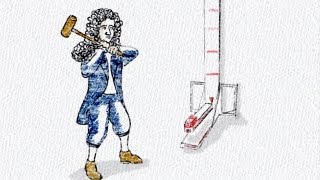(单词翻译:单击)
Have you ever noticed that it's harder to start pedaling your bicycle than it is to ride at a constant speed?
你有没有注意到,刚开始蹬车要比骑已经处于匀速的自行车难?
Or wondered what causes your bicycle to move?
又是否想过是什么让你的自行车动起来?
Or thought about why it goes forward instead of backwards or sideways?
又或者思考过为什么自行车是向前运动,而不是向后或者向旁边运动?
Perhaps not, and you wouldn't be alone.
也许没想过,而你也不是一个人。
It wasn't until the 17th century that Isaac Newton described the fundamental laws of motion
直到17世纪,艾萨克·牛顿描述了运动的基础定律,
and we understood the answer to these three questions.
我们才理解了这三个问题的答案。
What Newton recognized was that things tend to keep on doing what they are already doing.
牛顿发现,物体倾向于保持它所处的运动状态。
So when your bicycle is stopped, it stays stopped, and when it is going, it stays going.
所以,你的自行车停止的时候,它保持静止。当它开始运动的时候,它会持续前进。
Objects in motion tend to stay in motion and objects at rest tend to stay at rest.
运动中的物体,倾向于保持运动。而静止的物体,倾向于保持静止。
That's Newton's First Law. Physicists call it the Law of Inertia,
这是牛顿第一定律。物理学家称它为惯性定律,
which is a fancy way of saying that moving objects don't spontaneously speed up, slow down, or change direction.
这是对于运动中的物体不会主动加速、减速,或者改变方向的另一种说法
It is this inertia that you must overcome to get your bicycle moving.
你必须克服惯性才能踩动自行车。
Now you know that you have to overcome inertia to get your bicycle moving, but what is it that allows you to overcome it?
现在你知道你必须克服惯性才能使你的自行车行驶,但是,是什么让你克服惯性呢?
Well, the answer is explained by Newton's Second Law.
牛顿第二定律解释了这个问题。

In mathematical terms, Newton's Second Law says that force is the product of mass times acceleration.
用数学术语来说,牛顿第二定律指出,力是质量乘以加速度的乘积。
To cause an object to accelerate, or speed up, a force must be applied.
为了使物体有加速度,或者更快,就必须给予一个力。
The more force you apply, the quicker you accelerate.
你给的力越多,你的加速度越大。
And the more mass your bicycle has, and the more mass you have too,
如果你的自行车质量越大,或者你的质量也越大,
the more force you have to use to accelerate at the same rate.
你就需要更大的力来达到同样的加速度。
This is why it would be really difficult to pedal a 10,000 pound bicycle.
这就是为什么骑一个一万磅重的自行车会非常难。
And it is this force, which is applied by your legs pushing down on the pedals, that allows you to overcome Newton's Law of Inertia.
而这个力,就是通过你的腿,去踩脚踏板产生的力,使你克服了牛顿的惯性定律。
The harder you push down on the pedals, the bigger the force and the quicker you accelerate.
你踩脚踏板越使劲,力就越大,你的加速度就越大。
Now on to the final question: When you do get your bike moving, why does it go forward?
现在,最后一个问题:当你骑上你的自行车的时候,是什么使它向前行驶?
According to Newton's Third Law, for every action, there is an equal and opposite reaction.
根据牛顿的第三定律,每个正作用力都有一个对应同等的反作用力。
To understand this, think about what happens when you drop a bouncy ball.
要理解这个问题,可以想象一下扔弹力球。
As the bouncy ball hits the floor, it causes a downward force on the floor. This is the action.
当弹力球接触到地面的时候,球对地板产生了一个向下的力。这就是正作用力。
The floor reacts by pushing on the ball with the same force,
地板有一个推球的相同的力,
but in the opposite direction, upward, causing it to bounce back up to you.
但是相反的方向,是朝上的,这使得球弹回到你手中。
Together, the floor and the ball form what's called the action/reaction pair.
结合起来,地板和球形成了作用力和反作用力这两种力。
When it comes to your bicycle, it is a little more complicated.
回到自行车上来,就稍微有一些复杂了。
As your bicycle wheels spin clockwise, the parts of each tire touching the ground push backwards against the Earth: the actions.
当轮子顺时针转的时候,轮胎接触地面的地方有一个与地球相反方向,向后的推力:正作用力。
The ground pushes forward with the same force against each of your tires: the reactions.
地面则用同样的力向前推你的轮胎:反作用力。
Since you have two bicycle tires, each one forms an action/reaction pair with the ground.
因为你有两个轮胎,每一个都与地面形成了这一对力。
And since the Earth is really, really, really big compared to your bicycle,
然后,因为地球跟你的自行车比起来十分十分十分的大,
it barely moves from the force caused by your bicycle tires pushing backwards, but you are propelled forward.
所以它基本上没有因为你自行车轮子向后的推力而怎么移动,但是你被推着推着就前进了。


